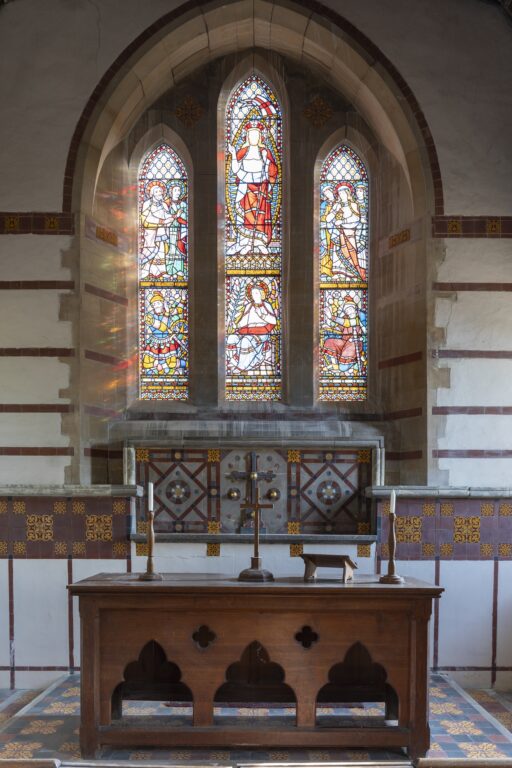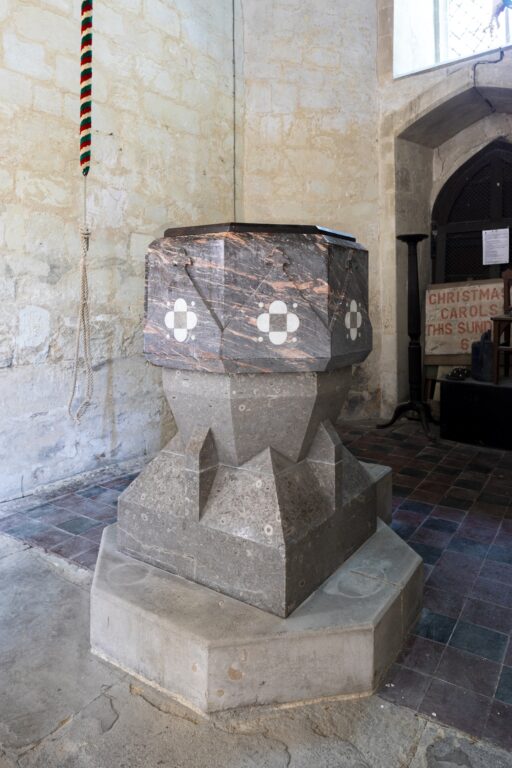
But has been cut off from its village by the busy B1042
On first inspection, St Giles’s appears to be a Butterfield bonanza: chequerboard tiles to the wall and floors, jewel-coloured marbles and polished stones, vivid stained glass and stencilled ceilings. But this Victorian restoration is a foil for a much, much older church.
St Giles’s is Grade II* listed. The chancel and aisleless nave, built from fieldstones and irregular blocks of Clunch (a chalky limestone) are substantially 13th century and retain lancet windows and a south doorway from the 1200s. In the south nave of the wall, a couple of windows date from about 100 years later, and the Clunch-constructed tower to the west was finished by 1472.
Internally, the tower is accessed through a nail-stuffed 16th/17th-century door set into a Tudor doorway. The doorway and walls to the tower’s spiral staircase are rich in graffiti.
The earliest surviving monument is a heavily-worn effigial slab just inside the south door that remembers Margaret Brogriffe (or Brograve), d.1493, with six children at her feet. Shards of medieval stained glass are retained in the south windows of the nave.
All other stained glass dates from restoration undertaken by the architect, William Butterfield in the mid-19th century. It’s likely that these were created by Alexander Gibbs – Butterfield’s preferred glazier. Richly coloured and joyous, the window in the nave illustrates the Annunciation and an inscription tells us that it was erected “by the labouring men and women / of this parish in the year of our Lord 1866”.
The east window dates from the same year and depicts the Resurrection. According to the inscription, it was commissioned by “Godfrey Milnes Sykes / Vicar of this parish and Mary Anne his wife / in the year of our Lord 1866.”


Alexander Gibbs wasn’t the only craftsperson Butterfield and the vicar worked with. The exposed rafters in the chancel are simply stencilled by Harland & Fisher. Plain and encaustic tiles, and marbles are arranged to create the geometric panels which flank a central cross of the reredos; this a Butterfield design which was brought to life by Field Poole & Sons. This is the same firm who made the font: a bowl of grey marble with pink veins and intaglio quatrefoils of bright white marble set on a highly-polished, fossil-rich base.
Butterfield’s campaign of restoration at St Giles’s spanned nearly twenty years (1855-1874). During this period he also worked at St Denis’s, East Hatley, just four miles away, which has been in our care since 2018.
Butterfield plastered the nave and chancel walls and painted them white. Thin strips of red tile run horizontally around the walls, including into the window reveals. The south windows are framed by an unusual sawtooth decoration cut into the plaster. All furnishings – the pulpit, communion rail, altar table, choirstalls and pews – were designed by Butterfield.



The buttons below link to church or information on other websites